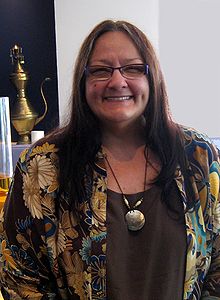Cheyenne and Arapaho Tribes
The Tsitsistas and the Suh' Tai are characterized, and represented by two cultural heroes who received divine articles which shaped the time-honored belief systems of the Southern and Northern families of the Cheyenne Nation.The Suh' Tai, represented by a man named Erect Horns, were blessed with the care of a sacred Buffalo Hat, which is kept among the Northern family.The Tsitsistas, represented by a man named Sweet Medicine, were bestowed with the care of a bundle of sacred Arrows, kept among the Southern Family.Inspired by Erect Horn's vision, they adopted the horse culture in the 18th century and moved westward onto the plains to follow the buffalo.Although the Arapaho had assisted the Cheyenne and Lakota in driving the Kiowa south from the Northern Plains, in 1840 they made peace with the tribe.They accepted a reservation with the Cheyenne in Indian Territory, so both tribes were forced to remove south near Fort Reno at the Darlington Agency in present-day Oklahoma.The tribal jurisdictional area includes Beckham, Blaine, Canadian, Custer, Dewey, Ellis, Kingfisher, Roger Mills, and Washita Counties.The Cheyenne-Arapaho Tribes of Oklahoma Culture and Heritage Program teaches hand games, powwow dancing and songs, horse care and riding, buffalo management, and Cheyenne and Arapaho language, and sponsored several running events.[11] In partnership with Southwestern Oklahoma State University, the tribe founded the Cheyenne and Arapaho Tribal College on August 25, 2006.



OklahomaEnglishArapaho languageCheyenne languageChristianityNative American ChurchSun DanceArapahoCheyenneGros VentreBlackfeetSuhtaifederally recognizedMinnesotaAlgonquian language familyhorse culturebuffaloprophetCouncil of Forty-fourwarrior societiesSaskatchewanMontanaWyomingColoradoSouth DakotaLakotaCivil WarFort Laramie TreatyMedicine Lodge TreatyKansasIndian TerritoryFort RenoDarlington AgencyDawes ActLand RunCurtis Act of 1898Oklahoma Indian Welfare ActIndian Self-Determination Act of 1975Southern CheyenneComancheYellow WolfPlatte RiverArkansas RiverBents FortDog SoldiersSand Creek MassacreNiobrara RiverUpper Smoky Hill RiverUpper Arkansas RiverStaked PlainsWhite AntelopeCheyenne RiverSouth Platte RiverWatongaCantonCheyenne and Arapaho Indian ReservationLakotiyapiOglala LakotaSičháŋǧu Oyáte (Brule Lakota)military societyBattle of Summit Springs of 1869Smoky Hill RiverSalineSolomon RiversRepublican RiverMa'ėhoohēvȧhtse (Red Shield Warriors Society)Cheyenne military societiescholeraBlack KettleBattle of Summit SpringsClintonHarvey PrattConcho, OklahomaBeckhamBlaineCanadianCusterKingfisherRoger MillsWashita Countieshand gamespowwowSouthwestern Oklahoma State UniversityHenrietta MannWeatherford, OklahomaBacone CollegeMuskogee, OklahomaBison bisonSuzan Shown HarjoRoss AndersonWilliam "Hawk" BirdsheadArchie BlackowlChris EyreSmoke SignalsMuscogeeViola HatchLance HensonYvonne KaugerChief Little RavenMerlin Little ThunderChief NiwotSt. David Pendleton OakerhaterTommy Orangeforensic artistHenry Roman NoseW. Richard West Sr.W. Richard West Jr.National Museum of the American IndianWolf RobeGilbert MilesWayback MachineBozeman Daily ChronicleNative American tribesFederallyrecognizedtribesAbsentee ShawneeAlabama-QuassarteApacheCherokeeChickasawChoctawCitizen PotawatomiDelaware NationDelaware TribeEastern ShawneeFort Sill ApacheKialegee